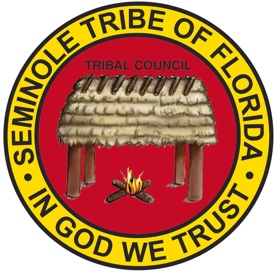Background
In 1957, the Seminole Tribe of Florida adopted its current constitution and was officially recognized as an Indian Tribe by the U.S. Congress. In 1977, the opening of the first “smoke shop” (offering discount, tax-free tobacco products) gave the Seminole Tribe of Florida a stable enterprise which continues, even today, to bring substantial revenue into tribal coffers. In 1979, the Seminole Tribe of Florida was the first Indian tribe to open a casino on Indian land. In 2006, the Seminole Tribe of Florida purchased the famed Hard Rock business, including its casinos, restaurants, hotels and an extensive collection of rock ’n’ roll memorabilia.
Today, the Seminole Tribe of Florida’s casinos support a growing infrastructure for the Seminole community’s health and welfare, public safety, education and other services. The economic stability provided by gaming, combined with the cattle, citrus, and other business enterprises, has made the Seminole Tribe of Florida one of the most successful Native American tribes in the United States.
The Challenge
The Seminole Tribe of Florida’s Legal Department handles a wide spectrum of matters, including governmental issues, gaming law issues, and a large number of document requests. As a staff attorney new to the department, Evonne Andris was used to leveraging the advantages of a computer based system, but the Seminole Tribe of Florida’s Legal Department filing system was paper based. “A lot of time was spent trying to decide where to file a particular document. And even once it was decided, ‘that goes in the green corporate file,’ someone would have to thumb through files to find the green corporate file.” A change was definitely needed.
“Additionally, our office’s filing system was based on subject matter. As our caseload started to increase, it became apparent that our subject-matter based filing system was not as comprehensive as we would have liked,” Andris said. “Our office came to the decision that it was time to move towards an electronic case management software system. The search for a system took about six months. The search process started with a comprehensive search for all case management software programs, we then narrowed the programs down to the software packages that were geared towards in-house counsel, and finally we received demonstrations from the top three programs that we felt would meet our objectives. The first demo we had with Legal Files was direct and to the point,” Andris said. “They listened to what we wanted and hit on all our points.”
The Results
“In just the first few months, the difference has been remarkable,” Andris said. “A file purge would be a six-week process, pulling the physical files from the cabinet, putting them in a storage box, typing a list of contents. Now, with Legal Files, we accomplish the same thing in one afternoon. We’re just so much more efficient.”
Legal Files has also significantly reduced the time it takes to open a file, and the automatic file numbering functionality has been a “blessing,” Andris said. “Plus, the ability to track the status of a file is wonderful. Someone from one of the government departments will call in and need to know the status of a matter, and it’s so easy, 1-2-3, I can tell them who is working on it, what the status is—anything. The improvement in our response time to our clients has been amazing.”
Ease of Implementation
“It was important for our office to start the New Year with a new filing system since we wanted to make a drastic change and move towards a numerical filing system,” Andris said. “Legal Files was installed in December 2007 and after training we were up and running by Jan. 1, 2008. Training was wonderful and there were no glitches. By the end of January 2008, we had even completed the migration of our open/pending 2007 files.”
Comprehensive Organization
“In my opinion, the best part of Legal Files is the Manage My Day page,” Andris said. Manage My Day is Legal Files’ home page or dashboard for a specific user that provides quick reference to files/cases, notifications/reminders and user activity all from one screen. “It allows me to have instant access to the files that I am currently working on,” she said.
A key part of Manage My Day is Legal Files’ automatic notification system called HeadsUp which Andris said she and other members of the office use frequently to track tasks/to-do’s, events and office communications. “We’re definitely a HeadsUp office,” Andris said. “It keeps us on task.”
Do-it-yourself Customization
Using Legal Files custom windows, the legal department also created its own “closed file” window. “We capture just the information we want to capture, whether that is the date the physical file was sent to storage or a bar code number,” Andris explained.
Bottom Line
“I would recommend Legal Files,” Andris said. “It can be customized to suit your organization’s needs, implementing the program is very simple, and the Legal Files support team is always willing to assist in any way they can.”

